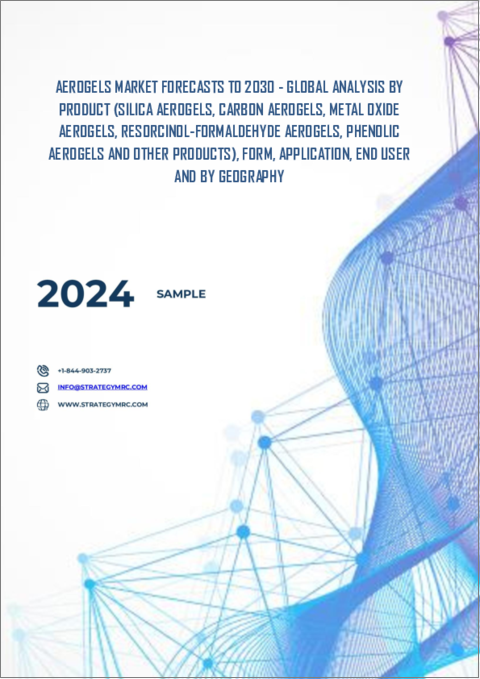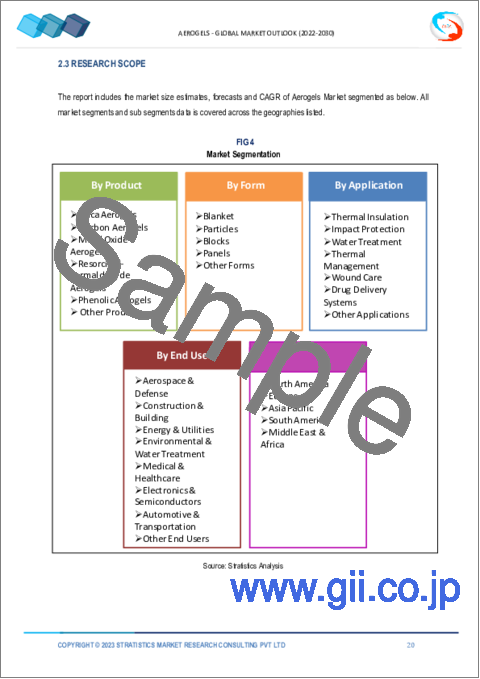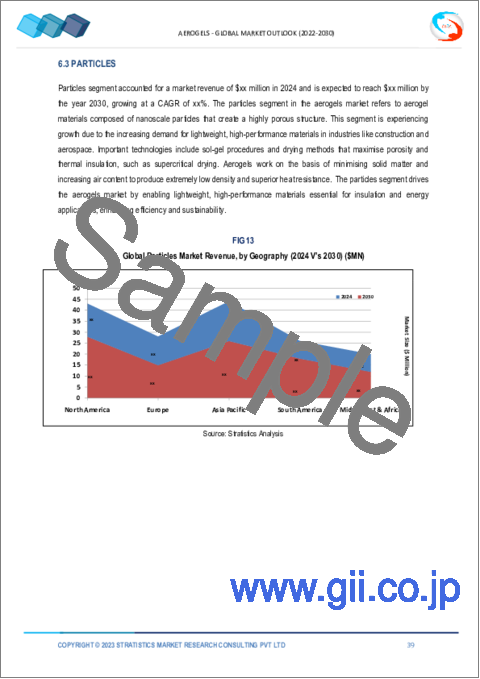|
|
市場調査レポート
商品コード
1551258
エアロゲル市場の2030年までの予測:製品別、形状別、用途別、エンドユーザー別、地域別の世界分析Aerogels Market Forecasts to 2030 - Global Analysis By Product (Silica Aerogels, Carbon Aerogels, Metal Oxide Aerogels, Resorcinol-Formaldehyde Aerogels, Phenolic Aerogels and Other Products), Form, Application, End User and By Geography |
||||||
カスタマイズ可能
|
|||||||
| エアロゲル市場の2030年までの予測:製品別、形状別、用途別、エンドユーザー別、地域別の世界分析 |
|
出版日: 2024年09月06日
発行: Stratistics Market Research Consulting
ページ情報: 英文 200+ Pages
納期: 2~3営業日
|
全表示
- 概要
- 図表
- 目次
Stratistics MRCによると、エアロゲルの世界市場は2024年に9億米ドルを占め、予測期間中にCAGR 14.8%で成長し、2030年には20億米ドルに達する見込みです。
エアロゲルは、液体成分を気体に置き換えたゲルから派生した、非常に多孔質で軽量な素材です。エアロゲルは半透明で密度が低いため、しばしば「凍った煙」と呼ばれます。エアロゲルは超臨界乾燥と呼ばれるプロセスで作られ、ゲルの構造を崩壊させることなくゲルから液体を除去します。その結果、表面積が非常に大きく、熱伝導率が低く、断熱性に優れた素材ができます。
米国エネルギー情報局によると、2023年の世界の原油生産量は1.76%増加し、日量1億174万9,000バレルとなりました。
優れた断熱性でエネルギー消費を削減
エアロゲルはその優れた断熱性で知られ、しばしば従来の素材を凌駕します。この効率は冷暖房のエネルギー使用量の削減につながり、省エネルギーと持続可能な建築を目指す世界の動向と一致しています。建設業界では、建設業者や建築家がエネルギー効率を高め、厳しい規制に適合する材料を求めているため、エアロゲルの需要が高まっています。同様に、航空宇宙や産業用途でも、エアロゲルはエネルギーコストの削減とシステム全体の性能向上に役立ち、市場の成長を牽引しています。
複雑な製造工程
エアロゲルの生産には、超臨界乾燥や精密な化学配合といった高度な技術が必要であり、生産コストの上昇につながる可能性があります。こうした複雑さは拡張性を制限し、従来の断熱材に比べてエアロゲルの普及を難しくしています。さらに、特殊な設備や専門知識が必要なため、新規メーカーにとっては参入障壁となり、エンドユーザーにとってはエアロゲルのコストが上昇します。このような複雑さは、生産時間の長期化にもつながり、サプライチェーンの効率に影響を与え、製品の入手を遅らせる可能性があります。
製造技術の革新
改良されたゾル-ゲル・プロセス、より優れた超臨界乾燥法、新規合成技術などの進歩により、より高品質なエアロゲルをより低コストで製造できるようになった。これらの技術革新は、製造工程をよりスケーラブルでコスト効率の良いものにし、様々な産業におけるエアロゲルの用途を広げます。例えば、製造時のエネルギー消費と廃棄物を削減する新しい方法は、エアロゲルの環境フットプリントを低減し、持続可能性を重視する市場によりアピールすることができます。
エアロゲルは損傷を受けやすい
エアロゲルは壊れやすく、機械的なストレスで割れたり、砕けたり、壊れたりしやすいです。この脆弱性は、耐久性と機械的弾力性が重要な環境での適用を制限します。建築や航空宇宙産業など、堅牢な材料が不可欠な産業では、エアロゲルの壊れやすい性質が大きな課題となります。取り扱いや設置の際の損傷を防ぐために保護層や包装を追加する必要があるため、コストと複雑さが増します。これは、特に高い耐久性と物理的ストレスへの耐性を必要とする用途において、エアロゲルを採用する潜在的なユーザーを思いとどまらせる可能性があり、市場の成長を妨げています。
COVID-19の影響:
COVID-19の大流行は当初、サプライチェーンの中断と産業活動の低下を通じてエアロゲル市場を混乱させました。しかし、ヘルスケアとエネルギー効率における先端素材の必要性も浮き彫りになった。パンデミックは、個人用保護具(PPE)や医療施設の断熱性向上といった用途でエアロゲルへの関心を加速させました。産業界が新たな安全基準や効率基準に適応するにつれて、エアロゲル市場は回復しつつあり、持続可能性とイノベーションへの注目が高まっています。
予測期間中は粒子セグメントが最大になる見込み
粒子は、ブランケットのエアロゲルよりも効率的な化学的・物理的特性を持つため、予測期間中に最大となる見込みです。これらの製品は、防衛、電子基板、建築・建設、輸送内装、アンテナなど様々な用途に使用されています。さらに、暖房や冷房に費やされるエネルギーが非効率な熱外皮のために浪費されるため、安全で信頼性が高く、エネルギー効率の高いシステムを構築する必要性の高まりが、市場の成長を後押ししています。
断熱材分野は予測期間中に最も高いCAGRが見込まれる
エネルギー効率の高い建物への需要や、航空宇宙や深海用途のような過酷な環境での効果的な断熱の必要性がエアロゲルの採用に拍車をかけているため、断熱材分野は予測期間中に最も高いCAGRが見込まれます。さらに、エアロゲルは軽量で表面積が大きいため、熱伝導を抑える効果があり、最小限の熱伝導率を必要とする用途に最適です。
最大のシェアを占める地域
北米は、航空宇宙、建築・建設、自動車、石油・ガスなどの最終用途産業からの需要増加により、予測期間中最大の市場シェアを占めると予測されます。北米市場は、エアロゲル市場の用途開拓、品質、製品革新の面で大きな成長の可能性を示しており、その一方で、優れた断熱性と低い熱伝導率特性が需要を牽引しています。
CAGRが最も高い地域:
欧州は、ドイツ、英国、スペイン、イタリアなどの国々のすべての建物にエネルギー消費量を20%削減することを義務付ける欧州連合のエネルギー効率政策により、予測期間中最も高いCAGRを維持すると予測されます。さらに、ドイツ、イタリア、英国、スペインなどの国々では、政府がインフラ整備のためのイニシアチブをとり、商業および住宅プロジェクトを後押ししています。
無料カスタマイズサービス:
本レポートをご購読のお客様には、以下の無料カスタマイズオプションのいずれかをご利用いただけます:
- 企業プロファイル
- 追加市場企業の包括的プロファイリング(3社まで)
- 主要企業のSWOT分析(3社まで)
- 地域セグメンテーション
- 顧客の関心に応じた主要国の市場推計・予測・CAGR(注:フィージビリティチェックによる)
- 競合ベンチマーキング
- 製品ポートフォリオ、地理的プレゼンス、戦略的提携に基づく主要企業のベンチマーキング
目次
第1章 エグゼクティブサマリー
第2章 序文
- 概要
- ステークホルダー
- 調査範囲
- 調査手法
- データマイニング
- データ分析
- データ検証
- 調査アプローチ
- 調査情報源
- 1次調査情報源
- 2次調査情報源
- 前提条件
第3章 市場動向分析
- 促進要因
- 抑制要因
- 機会
- 脅威
- 製品分析
- 用途分析
- エンドユーザー分析
- 新興市場
- COVID-19の影響
第4章 ポーターのファイブフォース分析
- 供給企業の交渉力
- 買い手の交渉力
- 代替品の脅威
- 新規参入業者の脅威
- 競争企業間の敵対関係
第5章 世界のエアロゲル市場:製品別
- シリカエアロゲル
- カーボンエアロゲル
- 金属酸化物エアロゲル
- レゾルシノール-ホルムアルデヒドエアロゲル
- フェノールエアロゲル
- その他の製品
第6章 世界のエアロゲル市場:形状別
- ブランケット
- 粒子
- ブロック
- パネル
- その他
第7章 世界のエアロゲル市場:用途別
- 断熱
- 衝撃保護
- 水治療
- 熱管理
- 創傷ケア
- ドラッグデリバリーシステム
- その他
第8章 世界のエアロゲル市場:エンドユーザー別
- 航空宇宙および防衛
- 建設・建築
- エネルギー・公益事業
- 環境・水治療
- 医療・ヘルスケア
- エレクトロニクスおよび半導体
- 自動車・輸送
- その他
第9章 世界のエアロゲル市場:地域別
- 北米
- 米国
- カナダ
- メキシコ
- 欧州
- ドイツ
- 英国
- イタリア
- フランス
- スペイン
- その他欧州
- アジア太平洋
- 日本
- 中国
- インド
- オーストラリア
- ニュージーランド
- 韓国
- その他アジア太平洋
- 南米
- アルゼンチン
- ブラジル
- チリ
- その他南米
- 中東・アフリカ
- サウジアラビア
- アラブ首長国連邦
- カタール
- 南アフリカ
- その他中東・アフリカ
第10章 主な発展
- 契約、パートナーシップ、コラボレーション、合弁事業
- 買収と合併
- 新製品発売
- 事業拡大
- その他の主要戦略
第11章 企業プロファイリング
- Active Aerogels
- Aerogel Technologies LLC
- Aerogel-it Gmbh
- Aspen Aerogels, Inc.
- BASF SE
- Cabot Corporation
- Dow, Inc.
- Enersens
- Guangdong Alison Hi-Tech Co., Ltd.
- JIOS Aerogel Corporation
- Nano Technology Co.
- Ningbo Surnano Aerogel Co. Ltd
- Sino Aerogel
- Svenska Aerogel AB
- Taasi Corporation
- Thermablok Aerogels Limited
List of Tables
- Table 1 Global Aerogels Market Outlook, By Region (2022-2030) ($MN)
- Table 2 Global Aerogels Market Outlook, By Product (2022-2030) ($MN)
- Table 3 Global Aerogels Market Outlook, By Silica Aerogels (2022-2030) ($MN)
- Table 4 Global Aerogels Market Outlook, By Carbon Aerogels (2022-2030) ($MN)
- Table 5 Global Aerogels Market Outlook, By Metal Oxide Aerogels (2022-2030) ($MN)
- Table 6 Global Aerogels Market Outlook, By Resorcinol-Formaldehyde Aerogels (2022-2030) ($MN)
- Table 7 Global Aerogels Market Outlook, By Phenolic Aerogels (2022-2030) ($MN)
- Table 8 Global Aerogels Market Outlook, By Other Products (2022-2030) ($MN)
- Table 9 Global Aerogels Market Outlook, By Form (2022-2030) ($MN)
- Table 10 Global Aerogels Market Outlook, By Blanket (2022-2030) ($MN)
- Table 11 Global Aerogels Market Outlook, By Particles (2022-2030) ($MN)
- Table 12 Global Aerogels Market Outlook, By Blocks (2022-2030) ($MN)
- Table 13 Global Aerogels Market Outlook, By Panels (2022-2030) ($MN)
- Table 14 Global Aerogels Market Outlook, By Other Forms (2022-2030) ($MN)
- Table 15 Global Aerogels Market Outlook, By Application (2022-2030) ($MN)
- Table 16 Global Aerogels Market Outlook, By Thermal Insulation (2022-2030) ($MN)
- Table 17 Global Aerogels Market Outlook, By Impact Protection (2022-2030) ($MN)
- Table 18 Global Aerogels Market Outlook, By Water Treatment (2022-2030) ($MN)
- Table 19 Global Aerogels Market Outlook, By Thermal Management (2022-2030) ($MN)
- Table 20 Global Aerogels Market Outlook, By Wound Care (2022-2030) ($MN)
- Table 21 Global Aerogels Market Outlook, By Drug Delivery Systems (2022-2030) ($MN)
- Table 22 Global Aerogels Market Outlook, By Other Applications (2022-2030) ($MN)
- Table 23 Global Aerogels Market Outlook, By End User (2022-2030) ($MN)
- Table 24 Global Aerogels Market Outlook, By Aerospace & Defense (2022-2030) ($MN)
- Table 25 Global Aerogels Market Outlook, By Construction & Building (2022-2030) ($MN)
- Table 26 Global Aerogels Market Outlook, By Energy & Utilities (2022-2030) ($MN)
- Table 27 Global Aerogels Market Outlook, By Environmental & Water Treatment (2022-2030) ($MN)
- Table 28 Global Aerogels Market Outlook, By Medical & Healthcare (2022-2030) ($MN)
- Table 29 Global Aerogels Market Outlook, By Electronics & Semiconductors (2022-2030) ($MN)
- Table 30 Global Aerogels Market Outlook, By Automotive & Transportation (2022-2030) ($MN)
- Table 31 Global Aerogels Market Outlook, By Other End Users (2022-2030) ($MN)
Note: Tables for North America, Europe, APAC, South America, and Middle East & Africa Regions are also represented in the same manner as above.
According to Stratistics MRC, the Global Aerogels Market is accounted for $0.9 billion in 2024 and is expected to reach $2.0 billion by 2030 growing at a CAGR of 14.8% during the forecast period. Aerogels are highly porous, lightweight materials derived from gels in which the liquid component is replaced with a gas. They are often referred to as "frozen smoke" due to their translucent appearance and low density. Aerogels are created through a process called supercritical drying, which removes the liquid from the gel without collapsing its structure. This results in a material with an extremely high surface area, low thermal conductivity, and excellent insulating properties.
According to the United States Energy Information Administration, global crude oil production in 2023 increased by 1.76% and was valued at 101.749 million barrels per day.
Market Dynamics:
Driver:
Superior insulation, reducing energy consumption
Aerogels are renowned for their exceptional thermal insulating properties, often outperforming traditional materials. This efficiency translates into lower energy usage for heating and cooling, aligning with global trends toward energy conservation and sustainable building practices. In the construction industry, the demand for aerogels is rising as builders and architects seek materials that enhance energy efficiency and comply with stringent regulations. Similarly, in aerospace and industrial applications, aerogels help in reducing energy costs and improving overall system performance driving the growth of the market.
Restraint:
Intricate production processes
The production of aerogels involves sophisticated techniques such as supercritical drying and precise chemical formulations, which can lead to elevated production costs. These complexities can limit scalability and make aerogels less accessible for widespread use compared to more conventional insulation materials. Additionally, the need for specialized equipment and expertise can create barriers to entry for new manufacturers and increase the cost of aerogels for end-users. This complexity can also result in longer production times, which may impact supply chain efficiency and delay product availability.
Opportunity:
Innovations in manufacturing techniques
Advances such as improved sol-gel processes, better supercritical drying methods, and novel synthesis techniques allow for higher quality aerogels at lower costs. These innovations make the production process more scalable and cost-effective, broadening the application of aerogels in various industries. For instance, new methods that reduce energy consumption and waste during production can lower the environmental footprint of aerogels, making them more appealing to sustainability-conscious markets.
Threat:
Aerogels are susceptible to damage
Aerogels are fragile and can be prone to cracking, crumbling, or breaking under mechanical stress. This vulnerability limits their applicability in environments where durability and mechanical resilience are crucial. In industries such as construction and aerospace, where robust materials are essential, the fragile nature of aerogels can pose significant challenges. The need for additional protective layers or packaging to prevent damage during handling and installation increases costs and complexity. This can deter potential users from adopting aerogels, particularly in applications requiring high durability and resistance to physical stress hampering the growth of the market.
Covid-19 Impact:
The COVID-19 pandemic initially disrupted the aerogels market through supply chain interruptions and reduced industrial activity. However, it also highlighted the need for advanced materials in healthcare and energy efficiency. The pandemic accelerated interest in aerogels for applications such as personal protective equipment (PPE) and improved thermal insulation in medical facilities. As industries adapt to new safety and efficiency standards, the market for aerogels is recovering, with increased focus on sustainability and innovation.
The particle segment is expected to be the largest during the forecast period
The particle is expected to be the largest during the forecast period owing to its efficient chemical and physical properties over blankets aerogels. These products have a variety of applications in defense, electronic substrates, building and construction, transport interiors, and antennas. Furthermore Rising necessity toward building safe, reliable and energy-efficient system as the energy spent on heating or cooling is wasted owing to ineffective thermal envelopes is driving the market growth.
The thermal insulation segment is expected to have the highest CAGR during the forecast period
The thermal insulation segment is expected to have the highest CAGR during the forecast period owing to the demand for energy-efficient buildings and the need for effective insulation in extreme environments, such as in aerospace and deep-sea applications, have spurred the adoption of aerogels. Additionally, aerogels' lightweight nature and high surface area contribute to their effectiveness in reducing heat transfer, making them ideal for applications requiring minimal thermal conductivity.
Region with largest share:
North America is projected to hold the largest market share during the forecast period owing to increasing demand from end-use industries including aerospace, building & construction, automotive, and oil & gas. The market in North America exhibits a huge growth potential in terms of application development, quality, and product innovation for the aerogel market, whereas the demand is driven by its superior insulation and low thermal conductivity properties.
Region with highest CAGR:
Europe is projected to hold the highest CAGR over the forecast period due to European Union's energy efficiency policy, which mandates all buildings across countries such as Germany, the UK, Spain, Italy, and others to reduce their energy consumption, by 20%. Moreover In countries such as Germany, Italy, the UK, and Spain, the governments have taken initiatives to develop infrastructure, boosting commercial and residential projects.
Key players in the market
Some of the key players in Aerogels market include Active Aerogels, Aerogel Technologies LLC, Aerogel-it Gmbh, Aspen Aerogels, Inc., BASF SE, Cabot Corporation, Dow, Inc., Enersens, Guangdong Alison Hi-Tech Co., Ltd., JIOS Aerogel Corporation, Nano Technology Co., Ningbo Surnano Aerogel Co. Ltd, Sino Aerogel, Svenska Aerogel AB, Taasi Corporation and Thermablok Aerogels Limited
Key Developments:
In July 2024, BASF backs Panasonic's launch of the first luminaire meeting the highest performance level in China. This luminaire uses BASF's optical film product NovaFlex GlareControl, and has become one of the first standing study luminaire products in China certified with the highest AAAAA performance level.
In July 2024, BASF launches game-changing heat and light stabilizer Tinuvin(R) NOR(R) 211 AR for sustainable farming practices. Tinuvin NOR 211 AR appears as an option to extend the useful life of agricultural plastics, promoting sustainability and efficiency.
In June 2024, Dow and Fiori Group sign MoU to develop sustainable solutions for circularity in the mobility market. This partnership allows both companies to work together along the European value chain, enlarging ecosystems to recycle materials obtained from end-of-life vehicles
Products Covered:
- Silica Aerogels
- Carbon Aerogels
- Metal Oxide Aerogels
- Resorcinol-Formaldehyde Aerogels
- Phenolic Aerogels
- Other Products
Forms Covered:
- Blanket
- Particles
- Blocks
- Panels
- Other Forms
Applications Covered:
- Thermal Insulation
- Impact Protection
- Water Treatment
- Thermal Management
- Wound Care
- Drug Delivery Systems
- Other Applications
End Users Covered:
- Aerospace & Defense
- Construction & Building
- Energy & Utilities
- Environmental & Water Treatment
- Medical & Healthcare
- Electronics & Semiconductors
- Automotive & Transportation
- Other End Users
Regions Covered:
- North America
- US
- Canada
- Mexico
- Europe
- Germany
- UK
- Italy
- France
- Spain
- Rest of Europe
- Asia Pacific
- Japan
- China
- India
- Australia
- New Zealand
- South Korea
- Rest of Asia Pacific
- South America
- Argentina
- Brazil
- Chile
- Rest of South America
- Middle East & Africa
- Saudi Arabia
- UAE
- Qatar
- South Africa
- Rest of Middle East & Africa
What our report offers:
- Market share assessments for the regional and country-level segments
- Strategic recommendations for the new entrants
- Covers Market data for the years 2022, 2023, 2024, 2026, and 2030
- Market Trends (Drivers, Constraints, Opportunities, Threats, Challenges, Investment Opportunities, and recommendations)
- Strategic recommendations in key business segments based on the market estimations
- Competitive landscaping mapping the key common trends
- Company profiling with detailed strategies, financials, and recent developments
- Supply chain trends mapping the latest technological advancements
Free Customization Offerings:
All the customers of this report will be entitled to receive one of the following free customization options:
- Company Profiling
- Comprehensive profiling of additional market players (up to 3)
- SWOT Analysis of key players (up to 3)
- Regional Segmentation
- Market estimations, Forecasts and CAGR of any prominent country as per the client's interest (Note: Depends on feasibility check)
- Competitive Benchmarking
- Benchmarking of key players based on product portfolio, geographical presence, and strategic alliances
Table of Contents
1 Executive Summary
2 Preface
- 2.1 Abstract
- 2.2 Stake Holders
- 2.3 Research Scope
- 2.4 Research Methodology
- 2.4.1 Data Mining
- 2.4.2 Data Analysis
- 2.4.3 Data Validation
- 2.4.4 Research Approach
- 2.5 Research Sources
- 2.5.1 Primary Research Sources
- 2.5.2 Secondary Research Sources
- 2.5.3 Assumptions
3 Market Trend Analysis
- 3.1 Introduction
- 3.2 Drivers
- 3.3 Restraints
- 3.4 Opportunities
- 3.5 Threats
- 3.6 Product Analysis
- 3.7 Application Analysis
- 3.8 End User Analysis
- 3.9 Emerging Markets
- 3.10 Impact of Covid-19
4 Porters Five Force Analysis
- 4.1 Bargaining power of suppliers
- 4.2 Bargaining power of buyers
- 4.3 Threat of substitutes
- 4.4 Threat of new entrants
- 4.5 Competitive rivalry
5 Global Aerogels Market, By Product
- 5.1 Introduction
- 5.2 Silica Aerogels
- 5.3 Carbon Aerogels
- 5.4 Metal Oxide Aerogels
- 5.5 Resorcinol-Formaldehyde Aerogels
- 5.6 Phenolic Aerogels
- 5.7 Other Products
6 Global Aerogels Market, By Form
- 6.1 Introduction
- 6.2 Blanket
- 6.3 Particles
- 6.4 Blocks
- 6.5 Panels
- 6.6 Other Forms
7 Global Aerogels Market, By Application
- 7.1 Introduction
- 7.2 Thermal Insulation
- 7.3 Impact Protection
- 7.4 Water Treatment
- 7.5 Thermal Management
- 7.6 Wound Care
- 7.7 Drug Delivery Systems
- 7.8 Other Applications
8 Global Aerogels Market, By End User
- 8.1 Introduction
- 8.2 Aerospace & Defense
- 8.3 Construction & Building
- 8.4 Energy & Utilities
- 8.5 Environmental & Water Treatment
- 8.6 Medical & Healthcare
- 8.7 Electronics & Semiconductors
- 8.8 Automotive & Transportation
- 8.9 Other End Users
9 Global Aerogels Market, By Geography
- 9.1 Introduction
- 9.2 North America
- 9.2.1 US
- 9.2.2 Canada
- 9.2.3 Mexico
- 9.3 Europe
- 9.3.1 Germany
- 9.3.2 UK
- 9.3.3 Italy
- 9.3.4 France
- 9.3.5 Spain
- 9.3.6 Rest of Europe
- 9.4 Asia Pacific
- 9.4.1 Japan
- 9.4.2 China
- 9.4.3 India
- 9.4.4 Australia
- 9.4.5 New Zealand
- 9.4.6 South Korea
- 9.4.7 Rest of Asia Pacific
- 9.5 South America
- 9.5.1 Argentina
- 9.5.2 Brazil
- 9.5.3 Chile
- 9.5.4 Rest of South America
- 9.6 Middle East & Africa
- 9.6.1 Saudi Arabia
- 9.6.2 UAE
- 9.6.3 Qatar
- 9.6.4 South Africa
- 9.6.5 Rest of Middle East & Africa
10 Key Developments
- 10.1 Agreements, Partnerships, Collaborations and Joint Ventures
- 10.2 Acquisitions & Mergers
- 10.3 New Product Launch
- 10.4 Expansions
- 10.5 Other Key Strategies
11 Company Profiling
- 11.1 Active Aerogels
- 11.2 Aerogel Technologies LLC
- 11.3 Aerogel-it Gmbh
- 11.4 Aspen Aerogels, Inc.
- 11.5 BASF SE
- 11.6 Cabot Corporation
- 11.7 Dow, Inc.
- 11.8 Enersens
- 11.9 Guangdong Alison Hi-Tech Co., Ltd.
- 11.10 JIOS Aerogel Corporation
- 11.11 Nano Technology Co.
- 11.12 Ningbo Surnano Aerogel Co. Ltd
- 11.13 Sino Aerogel
- 11.14 Svenska Aerogel AB
- 11.15 Taasi Corporation
- 11.16 Thermablok Aerogels Limited






